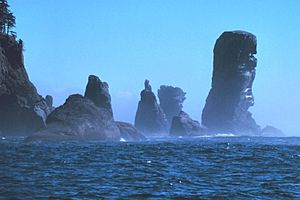Juan de Fuca facts for kids
Quick facts for kids
Juan de Fuca
|
|
|---|---|
| Born |
Ioannis Phokas
1536 Cephalonia, Venetian Ionian Islands (now Greece)
|
| Died | 1602 Cephalonia
|
| Nationality | Greek |
| Occupation | Maritime pilot |
Ioannis Phokas was a Greek sailor and explorer. He is better known by the Spanish version of his name, Juan de Fuca. He was born in 1536 on the Greek island of Cefalonia and died there in 1602.
Juan de Fuca worked for the King of Spain, Philip II. He is famous for saying he explored a sea passage. This passage is now called the Strait of Juan de Fuca. It is located between Vancouver Island in Canada and Washington state in the United States.
Contents
Family and Early Life
Juan de Fuca's family came from Constantinople. His grandfather, Emmanouíl Phokás, left Constantinople in 1453. This was when the city fell to invaders. Emmanouíl settled on the island of Cefalonia.
Juan de Fuca's father, Iákovos, lived in the village of Valerianos. Juan de Fuca was born in this village in 1536. We don't know much about his early life. He started working for Spain around 1555.
About His Name
The name "Juan de Fuca" can be a bit confusing. It is the Spanish way of saying his Greek name, Ioánnis Phokás. Some people thought his "real" name was Apóstolos Valeriános.
It's possible he was named Apóstolos at birth. Later, he might have used Ioánnis (which means John) because Apóstol (Apostle) was not a common name in Spanish. Phokás or Fuca was his family's last name. Valeriános was likely a nickname from his island home.
Early Career and Voyages
Juan de Fuca traveled a lot early in his career. He sailed to places like the Far East. He said he arrived in New Spain (which is now Mexico) in 1587. At that time, an English privateer named Thomas Cavendish captured his ship. This happened off the coast of Baja California.
Juan de Fuca was a very skilled sailor. He became an expert pilot in the Spanish fleet. He claimed the King of Spain recognized his talent. He said he was made a pilot for the Spanish navy. Before his most famous trip, he sailed to China, the Philippines, and Mexico. The Strait of Juan de Fuca was later named after him. This was done by British Captain Charles William Barkley.
Searching for a Northern Passage
Juan de Fuca said he went on two trips to explore. The Viceroy of New Spain, Luis de Velasco, marqués de Salinas, ordered these voyages. The goal was to find the famous Strait of Anián. People believed this was a Northwest Passage. This passage would be a sea route connecting the Atlantic and Pacific Oceans.
His first trip had 200 soldiers and three small ships. Juan de Fuca was the pilot and master of the ships. This expedition failed. The soldiers refused to follow orders and went back to California.
In 1592, Juan de Fuca went on his second voyage. This time, he was successful, according to his own story. He sailed north with two ships. He returned to Acapulco and claimed he had found the strait. He said there was a large island at its entrance. He placed it around 47° north latitude. The real Strait of Juan de Fuca is actually around 48° N. However, his description of sailing into it was different from what the area is really like.
During this trip, Juan de Fuca also saw a "high pinnacle or spired rock." This might have been Fuca Pillar. This is a tall, rectangular rock on the coast of Washington. It is located near the Strait of Juan de Fuca.
Juan de Fuca said the Viceroy promised him great rewards. But he never received them. After two years, he traveled to Spain to speak to the King. He was disappointed again. He decided to go back home to Kefallonia. In 1596, an Englishman named Michael Lok convinced him to work for Queen Elizabeth of England. Nothing came of their plans. But thanks to Lok's writings, Juan de Fuca's story became known in English.
Legacy
In 1787, an English captain named Charles William Barkley rediscovered the strait. He was sailing the ship Imperial Eagle. He renamed it the Strait of Juan de Fuca after the Greek explorer.
Other places are also named after him:
- The Juan de Fuca Ridge is an underwater mountain range.
- The Juan de Fuca Plate is a tectonic plate under the ocean.
- Juan de Fuca Provincial Park on Vancouver Island's West Coast.
- A hiking trail in the park also shares his name.
See also
 In Spanish: Juan de Fuca para niños
In Spanish: Juan de Fuca para niños


